Ida Gerhardi
Ida Gerhardi (2 August 1862 – 29 June 1927) was a German Neo-Impressionist painter who spent much of her career in Paris.
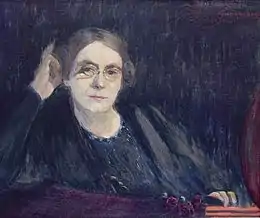
Biography
She was born in Hagen on 2 August 1862.[1] Her father was a medical doctor. After his early death in 1869, the family moved to Detmold, where she grew up. Although she had wanted to be a painter since she was a young girl, she was twenty-eight before she was able to pursue her ambitions. In 1890, she enrolled at the Women's Academy of the "Münchner Künstlerinnenverein" and studied with the landscape painter, Tina Blau.[2]
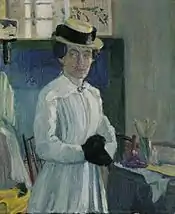
In 1891, she moved to Paris, where she studied at the Académie Colarossi, a popular school for foreign students. There, she befriended the composer, Frederick Delius, and his future wife, the painter Jelka Rosen. In 1900, she made the acquaintance of Auguste Rodin and joined the artistic circle at Le Dôme Café.[2]
At first, she worked as a landscape painter, inspired by the Barbizon school, but soon lightened her palette and began concentrating on portraits. She also did scenes from the amusement halls and pubs, which she visited with her friend, Käthe Kollwitz,[2] at a time when it was just beginning to be acceptable for unaccompanied women to visit such establishments.
She organized her own exhibitions and sold her works largely by herself. She also made purchases on behalf of Karl Ernst Osthaus, the founder of the Museum Folkwang, including works by Rodin and Aristide Maillol. In 1907, she organized an exhibition of French art in Berlin at the Galerie Eduard Schulte then, in turn, an exhibition of German art at a gallery called "Les Tendances Nouvelles" in Paris. She was a member of the Deutscher Künstlerbund and participated in exhibitions by both the Munich Secession and the Berlin Secession.[2]
Due to failing health, she had to give up her Paris studio in 1913 and return to Germany, where she lived with her relatives in Lüdenscheid.[3] Her work never reflected wartime themes, but her correspondences between 1914 and 1918 regularly referenced the ongoing war.[4] Gerhardi died in Lüdenscheid, Germany on 29 June 1927[1] from lung disease. Her remains were taken to Detmold.[2]
Her work was included in the 2015 exhibition Empathy and Abstraction: Modern Women in Germany at the Kunsthalle Bielefeld.[5][6]
Ida Gerhardi Förderpreis
In 1989, the Lüdenscheid Savings Bank, in collaboration with the Städtische Galerie Lüdenscheid, established the "Ida Gerhardi Förderpreis" (Sponsorship Prize). It is currently (2017) worth 5,000 Euros.[7] Notable recipients include Erich Reusch, Victor Bonato and Jochem Ahmann.
Selected paintings
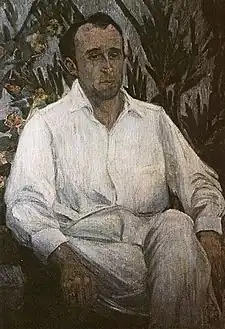 Frederick Delius
Frederick Delius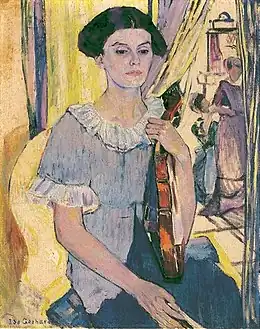 Violinist
Violinist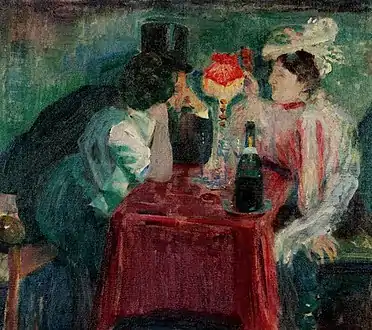 Bar Scene
Bar Scene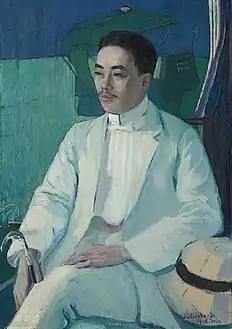 Siamese Prince
Siamese Prince
References
- "Ida Gerhardi". RKD. Retrieved 22 October 2021.
- Biography and additional references @ FemBio.
- Chennell, Paul (2009). "The Delius Society Journal" (PDF). The Delius Society Journal. 146: 23. Retrieved 12 August 2023.
- Siebrecht, Claudia (13 September 2013). The Aesthetics of Loss. Oxford University Press. ISBN 9780199656684. Retrieved 12 August 2023.
- "Empathy and Abstraction". e-flux.com. Retrieved 22 October 2021.
- "Ida Gerhardi". MutualArt. Retrieved 22 October 2021.
- "Ida Gerhardi-Förderpreis" [Ida Gerhardi Promotional Prize]. www.kulturpreise.de (in German). Retrieved 11 August 2023.
Further reading
- Vera Scheef, Die Künstlerin Ida Gerhardi 1862–1927. Detmold um 1900. ISBN 3-89528-435-1
- Susanne Conzen (Ed.), Ida Gerhardi-Deutsche Künstlerinnen in Paris um 1900, (Exhibition catalog), Hirmer, 2012 ISBN 978-3-7774-4791-9
- Annegret Rittmann (Ed.), Wozu die ganze Welt, wenn ich nicht malte, Ida Gerhardi, Briefe einer Malerin zwischen Paris und Berlin, Klartext, Essen 2012, ISBN 978-3-8375-0740-9
- Hans Gottlob: "Die Wegbegleiterinnen Ida Gerhardi und Jelka Rosen". In: Frederik Delius, der vergessene Kosmopolit, Bielefeld, 2012 ISBN 978-3-89528-964-4
External links
- The Ida Gerhardi Förderpreis website
- Literature by and about Ida Gerhardi in the German National Library catalogue
- Works by and about Ida Gerhardi in the Deutsche Digitale Bibliothek (German Digital Library)